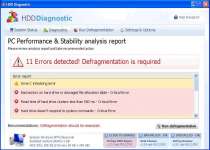HDD Diagnostic
Posted: December 7, 2010
Threat Metric
The following fields listed on the Threat Meter containing a specific value, are explained in detail below:
Threat Level: The threat level scale goes from 1 to 10 where 10 is the highest level of severity and 1 is the lowest level of severity. Each specific level is relative to the threat's consistent assessed behaviors collected from SpyHunter's risk assessment model.
Detection Count: The collective number of confirmed and suspected cases of a particular malware threat. The detection count is calculated from infected PCs retrieved from diagnostic and scan log reports generated by SpyHunter.
Volume Count: Similar to the detection count, the Volume Count is specifically based on the number of confirmed and suspected threats infecting systems on a daily basis. High volume counts usually represent a popular threat but may or may not have infected a large number of systems. High detection count threats could lay dormant and have a low volume count. Criteria for Volume Count is relative to a daily detection count.
Trend Path: The Trend Path, utilizing an up arrow, down arrow or equal symbol, represents the level of recent movement of a particular threat. Up arrows represent an increase, down arrows represent a decline and the equal symbol represent no change to a threat's recent movement.
% Impact (Last 7 Days): This demonstrates a 7-day period change in the frequency of a malware threat infecting PCs. The percentage impact correlates directly to the current Trend Path to determine a rise or decline in the percentage.
| Threat Level: | 10/10 |
|---|---|
| Infected PCs: | 16 |
| First Seen: | December 7, 2010 |
|---|---|
| Last Seen: | April 28, 2020 |
| OS(es) Affected: | Windows |
 HDD Diagnostic is another fake optimization tool that uses fake system error messages to lure users to purchase a useless product. HDD Diagnostic is installed in your system through a Trojan and is a clone of Hard Drive Diagnostic. The fake error messages claim to have detected serious problems on the computer hard drive and system memory. If you purchase HDD Diagnostic, it will not fix your computer problems. Affected PC users should use a reliable anti-spyware/anti-virus program to stop HDD Diagnostic from doing its dirty work immediately.
HDD Diagnostic is another fake optimization tool that uses fake system error messages to lure users to purchase a useless product. HDD Diagnostic is installed in your system through a Trojan and is a clone of Hard Drive Diagnostic. The fake error messages claim to have detected serious problems on the computer hard drive and system memory. If you purchase HDD Diagnostic, it will not fix your computer problems. Affected PC users should use a reliable anti-spyware/anti-virus program to stop HDD Diagnostic from doing its dirty work immediately.
Use SpyHunter to Detect and Remove PC Threats
If you are concerned that malware or PC threats similar to HDD Diagnostic may have infected your computer, we recommend you start an in-depth system scan with SpyHunter. SpyHunter is an advanced malware protection and remediation application that offers subscribers a comprehensive method for protecting PCs from malware, in addition to providing one-on-one technical support service.
* See Free Trial offer below. EULA and Privacy/Cookie Policy.
Why can't I open any program including SpyHunter? You may have a malware file running in memory that kills any programs that you try to launch on your PC. Tip: Download SpyHunter from a clean computer, copy it to a USB thumb drive, DVD or CD, then install it on the infected PC and run SpyHunter's malware scanner.
Technical Details
File System Modifications
Tutorials: If you wish to learn how to remove malware components manually, you can read the tutorials on how to find malware, kill unwanted processes, remove malicious DLLs and delete other harmful files. Always be sure to back up your PC before making any changes.
The following files were created in the system:%Temp%\9904eb.exe
File name: 9904eb.exeSize: 357.37 KB (357376 bytes)
MD5: 90497edc22b555872d616c305a440cc1
Detection count: 70
File type: Executable File
Mime Type: unknown/exe
Path: %Temp%
Group: Malware file
Last Updated: December 7, 2010
%Temp%\98cc87.exe
File name: 98cc87.exeSize: 357.37 KB (357376 bytes)
MD5: 3e3ab6660abf153c7cd623bc31ceb30e
Detection count: 62
File type: Executable File
Mime Type: unknown/exe
Path: %Temp%
Group: Malware file
Last Updated: December 7, 2010
%Temp%\98e2fd.exe
File name: 98e2fd.exeSize: 357.37 KB (357376 bytes)
MD5: 38afd99f0b87e593f1d326bab4649a3f
Detection count: 55
File type: Executable File
Mime Type: unknown/exe
Path: %Temp%
Group: Malware file
Last Updated: December 7, 2010
Registry Modifications
File name without pathHDD Diagnostic.lnkUninstall HDD Diagnostic.lnk
Leave a Reply
Please note that we are not able to assist with billing and support issues regarding SpyHunter or other products. If you're having issues with SpyHunter, please get in touch with SpyHunter customer support through your SpyHunter . If you have SpyHunter billing questions, we recommend you check the Billing FAQ. For general suggestions or feedback, contact us.